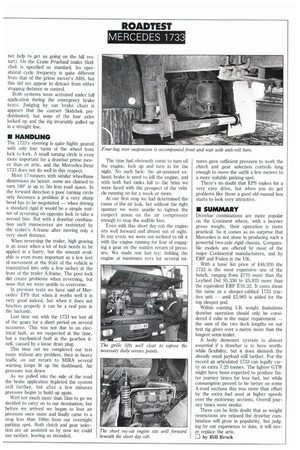ROADTEST MERCEDES 1733
Page 35

If you've noticed an error in this article please click here to report it so we can fix it.
not help to get us going on the hill restart). On the Crane Fruehauf trailer Skidchek is specified as standard. Its operational cycle frequency is quite different from that of the prime mover's ABS, but this did not appear to detract from either stopping distance or control.
Both systems were activated under full application during the emergency brake tests. Judging by our brake chart it appears that the coarser Skidchek predominated, but none of the four axles locked up and the rig invariably pulled up in a straight line.
• HANDLING
The 1733's steering is quite highly geared with only four turns of the wheel from lock to lock. A small turning circle is even more important for a drawbar prime mover than an artic, and the Mercedes-Benz 1733 does not do well in this respect.
Most 17-tonners with similar wheelbase dimensions do better: some are claimed to turn 180° in up to 5m less road space. In the forward direction a poor turning circle only becomes a problem if a very sharp bend has to be negotiated — when driving a standard rigid it would be a simple matter of reversing on opposite lock to take a second bite. But with a drawbar combination such manoeuvres are restricted by the trailer's A-frame after moving only a very short distance.
When reversing the trailer, high gearing is an asset when a lot of lock needs to be applied in a hurry, but the amount available is even more important as a few feet of movement at the front of the vehicle is transmitted into only a few inches at the front of the trailer A-frame. The poor lock did create problems when reversing, but none that we were unable to overcome.
In previous tests we have said of Mercedes' EPS that when it works well it is very good indeed, but when it does not function properly it can be a real pain in the backside.
Last time out with the 1733 we lost all of the gears for a short period on several occasions. This was not due to an electrical fault, as we suspected at the time, but a mechanical fault in the gearbox itself, caused by a loose drain plug.
This time out we completed our test route without any problem, then in heavy traffic on our return to MIRA several warning lamps lit up the dashboard. Air pressure was down.
As we pulled into the side of the road the brake application depleted the system still further, but after a few minutes pressure began to build up again.
With not much more than lkm to go we decided to carry on to our destination, but before we arrived we began to lose air pressure once more and finally came to a stop less than 100m from our overnight parking spot. Both clutch and gear selection are air assisted so by now we could use neither, leaving us stranded.
The time had obviously come to turn off the engine, lock up and turn in for the night. No such luck: the air-assisted exhaust brake is used to kill the engine, and with both fuel tanks full to the brim we were faced with the prospect of the vehicle running on for a week or more.
At our first stop we had determined the cause of the air leak, but without the right spanner we were unable to tighten the suspect union on the air compressor enough to stop the audible hiss.
Even with this short day cab the engine sits well forward and almost out of sight. In any event we were not inclined to tilt it with the engine running for fear of engaging a gear on the sudden return of pressure. We made one last try: holding the engine at maximum revs for several mi nutes gave sufficient pressure to work the clutch and gear selection controls long enough to move the outfit a few meters to a more suitable parking spot.
There's no doubt that EPS makes for a very easy drive, but when you do get problems like these a good old manual box starts to look very attractive.
• SUMMARY
Drawbar combinations are more popular on the Continent where, with a heavier gross weight, their operation is more practical. So it comes as no surprise that Mercedes is not alone in producing such a powerful two-axle rigid chassis. Comparable models are offered by most of the major Continental manufacturers, and by ERF and Foden in the UK.
With a basic list price of £48,920 the 1733 is the most expensive one of the bunch, ranging from £770 more than the Leyland Daf 95.330 to £5,925 more than the equivalent ERF E10.32. It costs about the same as a sleeper-cabbed 1733 tractive unit — until £5,965 is added for the top sleeper pod.
Within existing UK weight limitations drawbar operation should only be considered if cube is the major requirement — the sum of the two deck lengths on our test rig gives over a metre more than the longest semi-trailer.
A body demount system is almost essential if a drawbar is to have worthwhile flexibility, but it does diminish the already small payload still further_ For the record an articulated 1733 can legally carry an extra 7.25 tonnes. The lighter GTW might have been expected to produce faster journey times for less fuel, but while consumption proved to be better on some A-road sections this was more than offset by the extra fuel used at higher speeds over the motorway sections. Overall journey times were similar_ There can be little doubt that as weight restrictions are relaxed the drawbar combination will grow in popularity, but judging by our experience to date, it will never replace the artic.
































































